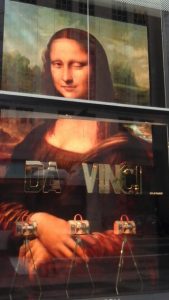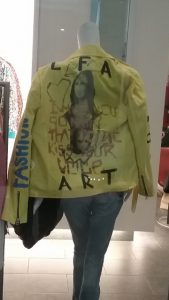The Work of Art in the Age of Its Mechanical Reproduction Summary
"The Piece of work of Art on the Age of Mechanical Reproduction" by Walter Benjamin was published in 1936, the inter state of war menstruum. "Having experienced Fascism and the fascist use of media in Federal republic of germany" [from Media & Cultural Studies Keyworks ed. by Durham and Kellner] Benjamin speaks to the transformation of the Marxian superstructure which he observed "has taken more than than a half century to manifest in all areas of civilisation the change in the atmospheric condition of production". Reflecting on the office of art in the 20th century, he explores a theory of art and the "useful formulation of revolutionary demands in the politics of art." [Preface] Since first reading this essay fifteen years ago, I've always been struck by its prescience and continual resonance in the digital age, and so please forgive the length of this provocation beyond the recommended 2-3 paragraph blog post.
Benjamin asserts that the piece of work of art has always been reproducible, but is quick to point out that mechanical reproduction, i.e., Marxian Capitalist mechanistic reproduction, through photography and film, represents something new. Benjamin discusses the profound repercussions that reproduction of works of art through photography, and the 'art of the film' accept had on fine art in its traditional class. [Section I] Given this context, what are your thoughts on Benjamin's argument that "fifty-fifty the most perfect reproduction of a work of fine art is lacking in ane element: its presence in fourth dimension and infinite, its unique beingness at the place where it happens to be," or in Benjamin-ian terms, its "aura". [Section II] Benjamin farther clarifies and defines the term "aura" of the piece of work of art equally "that which withers in the age of mechanical reproduction". Do you agree or disagree?
For this provocation, I'll use an example from art: does Leonardo da Vinci's Mona Lisa finish to exist the Mona Lisa if we remove her from the rooms in which Leonardo painted and her patron intended her or the Louvre where she has resided for many centuries and notwithstanding resides today? For example, more than specifically, an enlarged and interactive Mona Lisa is currently on display in the windows of fashion conglomerate LVMH at 5th Ave. and 57th Street and she fifty-fifty winks. She is featured in a collection of luxury leather products designed by creative person Jeff Koons entitled "MASTERS" that retails for approx. $585.00 – $4,000.00. Here's a recent photo of the brandish:

Mona Lisa is also currently on display at my local mall via a jacket design:
Practise y'all think such reproduction erodes, or conversely, enhances the Benjamin-ian aura of this work of art?
Benjamin attributes social bases for the "gimmicky decay of the aura" and that these "rest on two circumstances, both of which are related to the increasing significance of the masses in contemporary life." [Section Three] What are your thoughts on this?
While the contemporary cult of the Mona Lisa carries on in our modernistic way world today, Benjamin states that "originally, the contextual integration of fine art in tradition found its expression in the cult" and he clarifies, "in other words, the unique value of the 'authentic' piece of work of fine art has its basis in ritual, the location of its original utilise value" and he proceeds with "an all-important insight: for the first fourth dimension in world history, mechanical reproduction emancipates the work of art from its parasitical dependence on ritual." Benjamin and then points out a paradox that "to an e'er greater degree the piece of work of art reproduced becomes the piece of work of art designed for reproducibility." Cautioning, he qualifies this with: "Merely the instant that the criterion of actuality ceases to be applicable to creative product, the total function of art is reversed. Instead of beingness based on ritual, it begins to be based on another practice – politics." [Section IV] Do you think the post-millennial role of art is ane of ritual, politics or both? Can you cite examples of works of art to illustrate your point of view?
The Internet, and our use of it, are for us, in my stance based upon Benjamin, the ultimate mechanical reproduction of fine art and exhibition infinite (another important concept to Benjamin). Acting as the mass which "is a matrix from which all traditional behavior toward works of art problems today in a new form" [Section XV] the Internet'due south inherent mechanical reproduction is the ultimate emancipation of fine art, and I'd add, likewise its paradoxical enslavement of fine art to the new rituals of clicking, copying, pasting, scanning, uploading, downloading, swiping, posting, re-posting, tweeting, re-tweeting, liking, favorite-ing and deleting.
While information technology is piece of cake for me to grasp the deposition of the Benjamin-ian aura in the work of art, because all one has to practise is photocopy the Mona Lisa from an fine art book or copy information technology from a website and see the loss of resolution and aesthetic quality with each generation, one must ask rhetorically how Benjamin foresaw this without the benefit of Xerox, Photoshop, the World Wide Web, apps such equally Instagram and filters. Do you lot find "The Piece of work of Fine art in the Historic period of Mechanical Reproduction" as forward thinking as I do? Does it hold up in the digital age?
I cannot overlook that this provocation is assigned and intended for the readings for our Sept. xi grade, and it brings to mind some remarks made by the writer of "Prozac Nation" Elizabeth Wurtzel. They struck me then and still practise now, as reminiscent of the Epilogue in which Benjamin theorizes that war is the ultimate piece of work of art. Wurtzel was asked nigh the events of Sept. 11, 2001 in February 2002 during an interview to promote her book More, Now, Over again by the Toronto World and Postal service in the context of her residency shut to the Earth Trade Center, and she commented as follows: 'I had non the slightest emotional reaction. I thought, this is a really strange fine art project…information technology was a most astonishing sight in terms of sheer elegance. It fell like water. It just slid, similar a turtleneck going over someone's head.' (Her comments set off a stupor moving ridge and likely acquired her film for "Prozac Nation" made by Miramax not to be released.) For me, these comments brought to mind words of Benjamin I have difficulty typing and relaying that "war is beautiful" and that "through gas warfare the aureola is abolished in a new style." Writing in his time and place, Benjamin quotes Fascism "Fiat ars – pereat mundus" (translation: permit art be created, though the world perish) which was the Fascist spin on "l'art pour l'art" (art for fine art's sake) and concludes by conjecturing "state of war to supply the creative gratification of a sense of perception that has been changed by technology." [Epilogue] Do y'all detect this to be the logical and probable post-Marxian evolution?
Related Video Clip: Does this video of LVMH's Titian window (detail from the painting of Mars, Venus and Cupid) disuse its aura or heighten it?
Related Resources:
"Jeff Koons'due south New Line" by Vanessa Friedman, The New York Times, April 11, 2017
"The Louis Vuitton x Jeff Koons Bags May Be My Least Favorite Designer Collab Ever" by Amanda Mull on purseblog, Apr thirteen, 2017
"Release Me" by John Harris, The Guardian, July 17, 2004
"Mona Lisa & an Iguana on 5th" by Carolyn A. McDonough, on CultureArtMedia, September i, 2017
weisevoiceselen1954.blogspot.com
Source: https://itpcore1fall2017.commons.gc.cuny.edu/2017/09/07/the-work-of-art-in-the-age-of-mechanical-reproduction-by-walter-benjamin/
0 Response to "The Work of Art in the Age of Its Mechanical Reproduction Summary"
Post a Comment